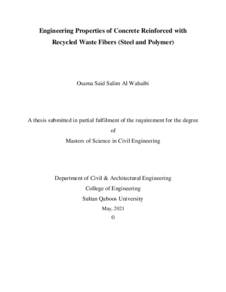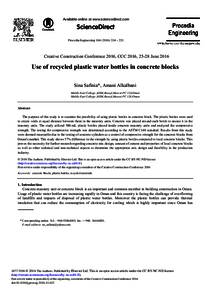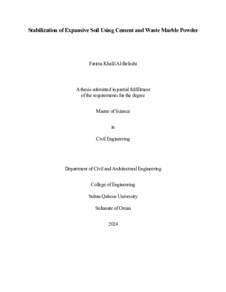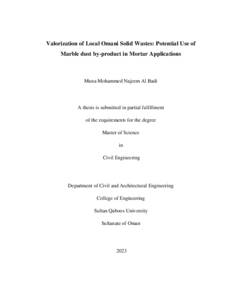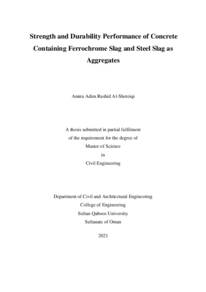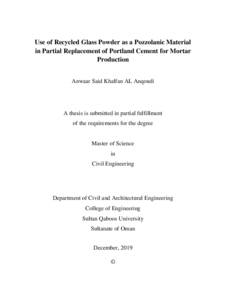Document
Engineering properties of concrete reinforced with recycled waste fibers (Steel and Polymer).
Other titles
الخصائص الهندسية للخرسانة المسلحة بألياف النفايات المعاد تدويرها (الحديد والبوليمر)
Publisher
Sultan Qaboos University.
Gregorian
2021
Language
English
English abstract
Concrete is considered as a brittle material in absence of reinforcement. To promote and implement
the sustainability concept in construction, it is important to investigate and study the properties of
available resources of materials in order to utilize them as reinforcement materials in concrete.
Nowadays, and considering the sustainable development context, worldwide researches have been
devoted to the use of different types of fibers in concrete.
This study aims to investigate and examine the mechanical behavior of fiber reinforced concrete
(FRC) by using three types of waste fibers: steel fibers from used tire, waste soda bottle plastic
and waste fishing net at different contents and lengths. A proper experimental work was designed
and conducted for this research to assess the behavior of concrete reinforced with waste fibers.
The experimental work consists of fresh properties of FRC, compressive strength, flexural
strength, splitting tensile strength, load vs. deflection and porosity tests.
The workability of all (FRCs) was reduced when adding waste fibers and this reduction found to
be more significant when fiber`s length and volume increases. FRC with steel (SFRC) showed the
highest reduction in workability compared to all other FRCs. A relative compressive strength loss
up to 45% was recorded when introducing different types of fibers. The mean tensile strength loss
and gain is ranging from 3% to 27% and 1% to 15%, respectively. The FRC with polypropylene
fibers (PPF) performs better than other FRC with more tensile strength improvement. Fiber
inclusion has resulted in an increase in the flexural strength up to 26%. Thick SFRC showed the
highest improvement whereas fishing mesh (FM) FRC had the lowest flexural strength
improvement. Energy absorption under flexural loading was greatly enhanced for all FRCs with a
relative energy absorption gain ranging from 7% to 800%. The SFRCs were found to reach the
maximum post peak load-deflection and ductility compared to the FMF & PPF. Moreover, hybrid
fibers reinforced concrete (HFRC) has not only improved the post-cracking behavior of the
multimodal composites but also its flexural strength by around 12% compared to the single fiber
composite. The porosity of FRCs increased compared to the unreinforced control concrete.
Porosity also increased as the content and length of fibers increase.
Member of
Resource URL
Arabic abstract
عتبر الخرسانة مادة هشة في حالة عدم وجود حديد التسليح ، لذلك من المهم تحقيق الاستدامة لفحص ودراسة خصائص المصادر
المتاحة من المواد الاخرى من أجل الاستفادة منها كقوة تسليح في الخرسانة ، ففي الوقت الحاضر يتم تكريس الابحاث في جميع
أنحاء العالم لاستخدام أنواع مختلفة من الألياف في الخرسانة.
تهدف هذه الدراسة إلى دراسة واختبار السلوك الميكانيكي للخرسانة المسلحة بالالياف (FRC (باستخدام ثلاثة أنواع من الألياف
النفايات: نفايات الاطارات من الألياف المعدنية ، وألياف البولي بروبلين الناتجة من النفايات البلاستيكية لعلب نفايات الصودا
البلاستيكية وشباك صيد الأسماك وذلك بكميات محددة وأطوال مختلفة ، فقد تم إجراء اختبارات تجريبية لهذا البحث للحصول
على نتائج حول سلوك الخرسانة المسلحة بالألياف ، وتشمل الفحوصات اختبار انسيابية تدفق الخلطة الخرسانية في حالتها
الطرية واختبارات قوة الانضغاط وقوة الانحناء وقوة الشد أثناء الانقسام واختبار المسامية في الحالة الصلبة للخرسانة.
تبين من خالل نتائج الاختبارات انخفاض انسيابية تدفق الخلطة الخرسانية عند إضافة الألياف ، ووجد أن هذا الانخفاض يكون
أكثر عندما يزداد طول الألياف وكميتها خصوصا عند إضافة الألياف المعدنية ، كما تم مالحظة انخفاض مقاومة الانضغاط
بنسبة تصل إلى ٪45 عند تسليح الخرسانة بأنواع مختلفة من الألياف ، فيما يتراوح متوسط الانخفاض والزيادة في مقاومة الشد
أثناء الانقسام من ٪3 إلى ٪27 و ٪1 إلى ٪15 على التوالي ، حيث تعمل الخرسانة المسلحة بألياف البولي بروبلين الناتجة
بشكل أفضل من غيرها في تحسين قوة الشد أثناء الانقسام . وقد نتج عن استخدام الألياف في تسليح الخرسانة زيادة في قوة
الانحناء تصل إلى ٪26 حيث أظهرت الألياف المعدنية السميكة أعلى زيادة بينما حققت الألياف الناتجة من مخلفات شباك الصيد
أقل تحسن في قوة الانحناء ، إضافة إلى ذلك فقد تبين تحسين مستوى امتصاص الطاقة بشكل كبير وذلك عند تعرض الخرسانة
إلى قوة الانحناء ، حيث أظهرت جميع أنواع الخرسانات المسلحة بالألياف نسب امتصاص للطاقة تتراوح من ٪7 إلى ٪800
، وقد حققت الألياف المعدنية تمدد أعلى بعد الوصول إلى الحد الاقصى من الحمل ، كما أن الخرسانة المسلحة بالألياف الهجينة
٪ مقارنةً لم تحسن فقط سلوك التمدد بعد التشقق الاولي ولكن أيًضا أظهرت زيادة في قوة الانحناء بحوالي 12 بمركب الألياف
الاحادية ، أما فيما يتعلق باختبار المسامية فقد تبين زيادة المسامية في الخرسانات المسلحة بالألياف مقارنة بخرسانة التحكم غير
المسلحة ، وأن هذه المسامية تزيد كلما زادت كمية وطول الألياف.
المتاحة من المواد الاخرى من أجل الاستفادة منها كقوة تسليح في الخرسانة ، ففي الوقت الحاضر يتم تكريس الابحاث في جميع
أنحاء العالم لاستخدام أنواع مختلفة من الألياف في الخرسانة.
تهدف هذه الدراسة إلى دراسة واختبار السلوك الميكانيكي للخرسانة المسلحة بالالياف (FRC (باستخدام ثلاثة أنواع من الألياف
النفايات: نفايات الاطارات من الألياف المعدنية ، وألياف البولي بروبلين الناتجة من النفايات البلاستيكية لعلب نفايات الصودا
البلاستيكية وشباك صيد الأسماك وذلك بكميات محددة وأطوال مختلفة ، فقد تم إجراء اختبارات تجريبية لهذا البحث للحصول
على نتائج حول سلوك الخرسانة المسلحة بالألياف ، وتشمل الفحوصات اختبار انسيابية تدفق الخلطة الخرسانية في حالتها
الطرية واختبارات قوة الانضغاط وقوة الانحناء وقوة الشد أثناء الانقسام واختبار المسامية في الحالة الصلبة للخرسانة.
تبين من خالل نتائج الاختبارات انخفاض انسيابية تدفق الخلطة الخرسانية عند إضافة الألياف ، ووجد أن هذا الانخفاض يكون
أكثر عندما يزداد طول الألياف وكميتها خصوصا عند إضافة الألياف المعدنية ، كما تم مالحظة انخفاض مقاومة الانضغاط
بنسبة تصل إلى ٪45 عند تسليح الخرسانة بأنواع مختلفة من الألياف ، فيما يتراوح متوسط الانخفاض والزيادة في مقاومة الشد
أثناء الانقسام من ٪3 إلى ٪27 و ٪1 إلى ٪15 على التوالي ، حيث تعمل الخرسانة المسلحة بألياف البولي بروبلين الناتجة
بشكل أفضل من غيرها في تحسين قوة الشد أثناء الانقسام . وقد نتج عن استخدام الألياف في تسليح الخرسانة زيادة في قوة
الانحناء تصل إلى ٪26 حيث أظهرت الألياف المعدنية السميكة أعلى زيادة بينما حققت الألياف الناتجة من مخلفات شباك الصيد
أقل تحسن في قوة الانحناء ، إضافة إلى ذلك فقد تبين تحسين مستوى امتصاص الطاقة بشكل كبير وذلك عند تعرض الخرسانة
إلى قوة الانحناء ، حيث أظهرت جميع أنواع الخرسانات المسلحة بالألياف نسب امتصاص للطاقة تتراوح من ٪7 إلى ٪800
، وقد حققت الألياف المعدنية تمدد أعلى بعد الوصول إلى الحد الاقصى من الحمل ، كما أن الخرسانة المسلحة بالألياف الهجينة
٪ مقارنةً لم تحسن فقط سلوك التمدد بعد التشقق الاولي ولكن أيًضا أظهرت زيادة في قوة الانحناء بحوالي 12 بمركب الألياف
الاحادية ، أما فيما يتعلق باختبار المسامية فقد تبين زيادة المسامية في الخرسانات المسلحة بالألياف مقارنة بخرسانة التحكم غير
المسلحة ، وأن هذه المسامية تزيد كلما زادت كمية وطول الألياف.
Category
Theses and Dissertations

